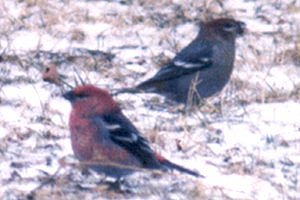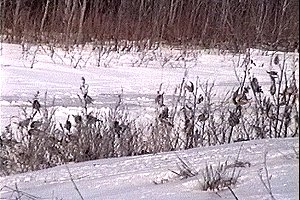RON PITTAWAY'S WINTER FINCH FORECAST
2001 - 2002
(Reproduced with author's permission.)
|
|
Note: This page gives the text of Ron Pittaway's informative, educational and always interesting Winter Finch Forecast. He has gathered information regarding conditions in the northern boreal forests and synthesized this to forecast the occurrance of these birds in southern Ontario. There are excellent tidbits about food tree preferences of the various finch species and subspecies, and forest conditions overall. It will help you think globally to find birds locally. Many thanks to Ron for allowing us to offer this report to our visitors. (Photos added by NeilyWorld.)
|
|
Return to the Birding Ottawa Past Years' Pittaway's Winter Finch Forecasts pages.
Check the current Birding Ottawa Pittaway Winter Finch Report page.
Check the current Birding Ottawa Winter Specialty Status page.
Check the Birding Ottawa Current Ottawa Winter List.
Return to Birding Ottawa Where and When to See Guide.
Return to Birding Ottawa Table of Contents.
Ron Pittaway's Winter Finch Forecast for 2001 - 2002
The severe drought this summer has contributed to a generally poor tree seed crop in Ontario. My forecast is that the usual winter finch hotspots such as Algonquin Park (190 km/120 mi north of Lake Ontario) will have low numbers of finches this winter. White Pine has a light cone crop in places, but it's spotty. What few cones there are will likely be harvested and stored this fall by Red Squirrels, leaving little food for the pine forms of the Red Crossbill. White Cedar has a moderate crop, perhaps attracting a few Pine Siskins as they move through this fall. Most winters, such as this upcoming one, the majority of siskins leave Ontario unless there are bumper cone crops, particularly on White Spruce and Eastern Hemlock. The two aforementioned trees also attract White-winged Crossbills and hemlocks attract the small-billed form of the Red Crossbill, but not this year. If any White-winged Crossbills are around this winter in Algonquin, they'll be in lowland Black Spruce, which always has some long lasting cones. Most Purple Finches probably will depart Ontario in October because of poor seed crops and return mid-April to mid-May. Evening Grosbeak numbers have declined noticeably over the past 10 to 15 years in Ontario. One of the last Algonquin Christmas Bird Counts to have very high numbers of Evening Grosbeaks was in 1984 with 1474 individuals, which was a North American record high for that year. A few Evenings may show up at feeders this winter in sourthern Ontario (or keep on going) because there's little food to hold them farther north. Good News: I forecast that Pine Grosbeaks and Common Redpolls will be in southern Ontario this winter, perhaps in numbers. See below.
PINE GROSBEAK: In winter, Pine Grosbeak numbers in the boreal forest are linked to American and Showy Mountain-ash berries. They eat the seeds inside the berry, discarding the fleshy part. Pine Grosbeaks stay north when Mountain-ash berries are numerous. My spies in northern Ontario tell me that there's fair to moderate crop of Mountain-ash berries in some areas, but their quality probably has been affected by the drought. Expect to see Pine Grosbeaks eating tree buds (often high in trees) and getting salt/sand on Highway 60 in Algonquin Park this winter. Other Pines will likely appear in settled areas where they'll feed in fruit trees such as crabapples (moderate crop in Toronto) and planted European Mountain-ash (moderate to spotty crop in Toronto). Watch for Pines this winter at your feeder where they prefer sunflower seeds.
 Pine Grosbeaks (Pinicola enucleator)
Pine Grosbeaks (Pinicola enucleator)
COMMON REDPOLLS: In the boreal forest in winter, redpolls depend on birch (and alder) seeds. Birch has good seed crops roughly every two years with some seeds most years. This year, however, my sources in northern Ontario say that the birch seed crop is very poor. The same is true in Algonquin and the Haliburton Highlands, so redpolls won't be held there as they move south in search of food. Expect to see redpolls at your feeders and in weedy fields this winter. If we get large numbers of Common Redpolls, watch for Hoary Redpolls which in my experience there's 1 Hoary for every 200 Common Redpolls. Most streaked first year (first basic plumage) female Hoarys are overlooked. Winter finch forecasting is a tricky pastime. I find it fun to look at the indicators and make predictions based on tree seed crops and historical patterns. Some finch species (not most I hope) could prove me wrong this winter.
 Flock of Common Redpolls (Carduelis flammea)
Flock of Common Redpolls (Carduelis flammea)
Canadians are deeply saddened by the horrifying events yesterday in the United States. Our federal, provincial and municipal governments and all Canadians are ready to help our American neighbors.
Happy birding,
Ron Pittaway
Minden, Ontario
E-mail: jeaniron@sympatico.ca
Return to the Birding Ottawa Past Years' Pittaway's Winter Finch Forecasts pages.
Check the current Birding Ottawa Pittaway Winter Finch Report page.
Check the current Birding Ottawa Winter Specialty Status page.
Check the Birding Ottawa Current Ottawa Winter List.
Return to Birding Ottawa Where and When to See Guide.
Return to Birding Ottawa Table of Contents.
|

